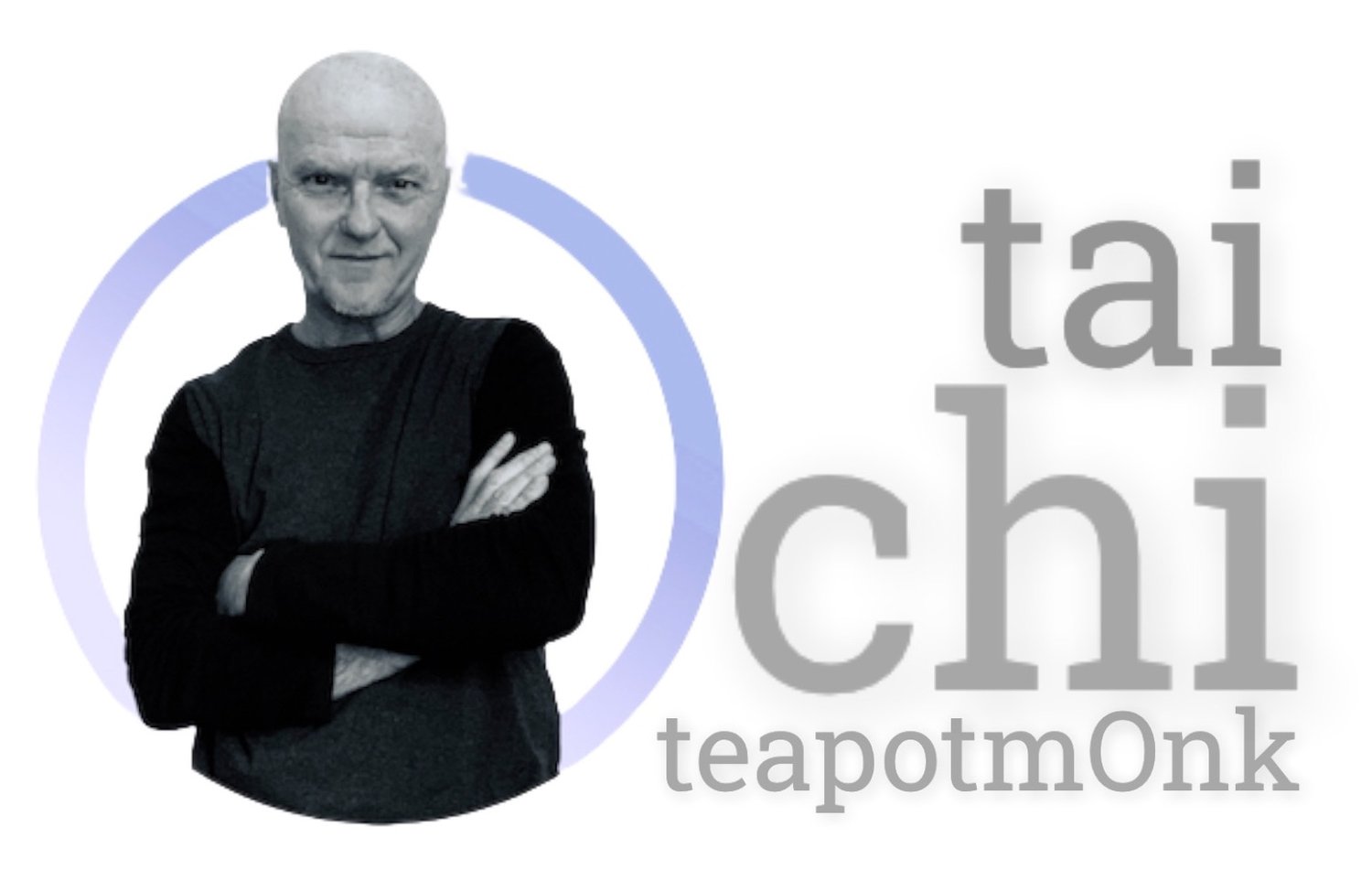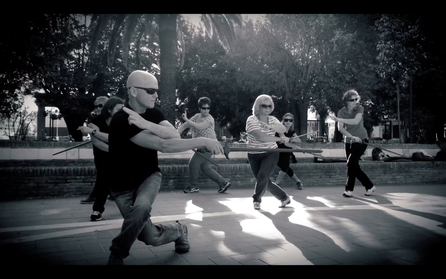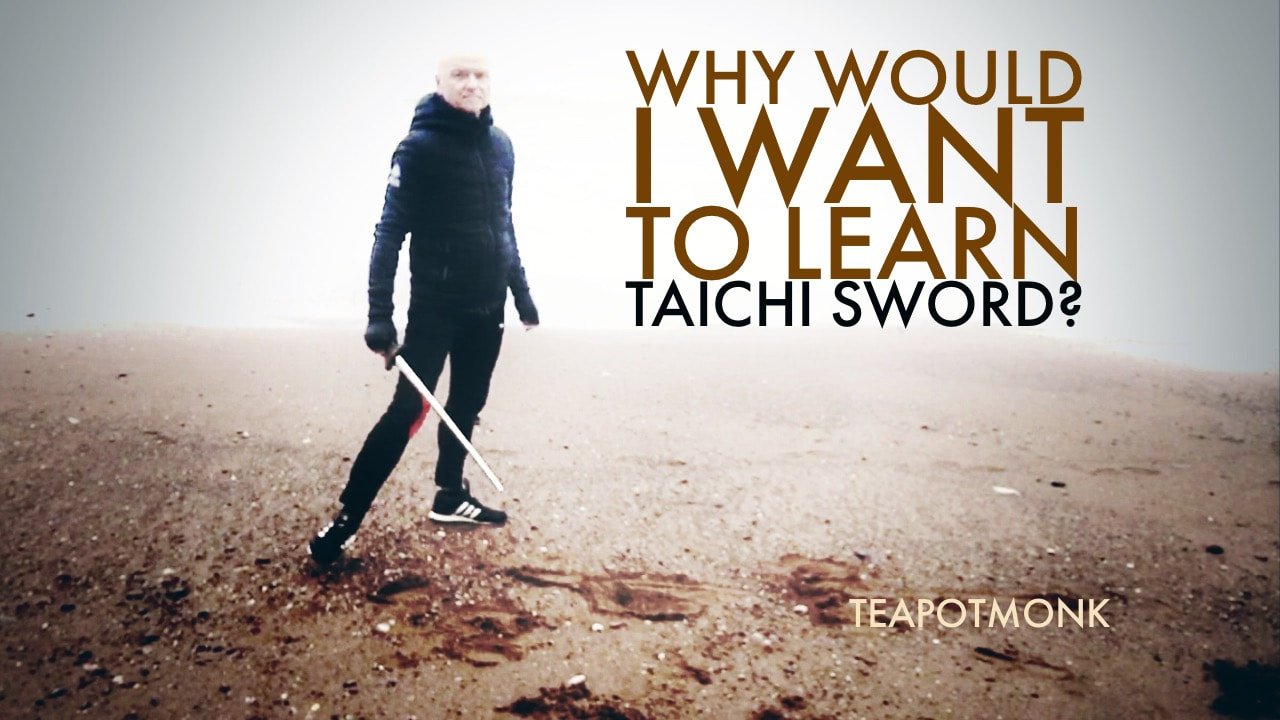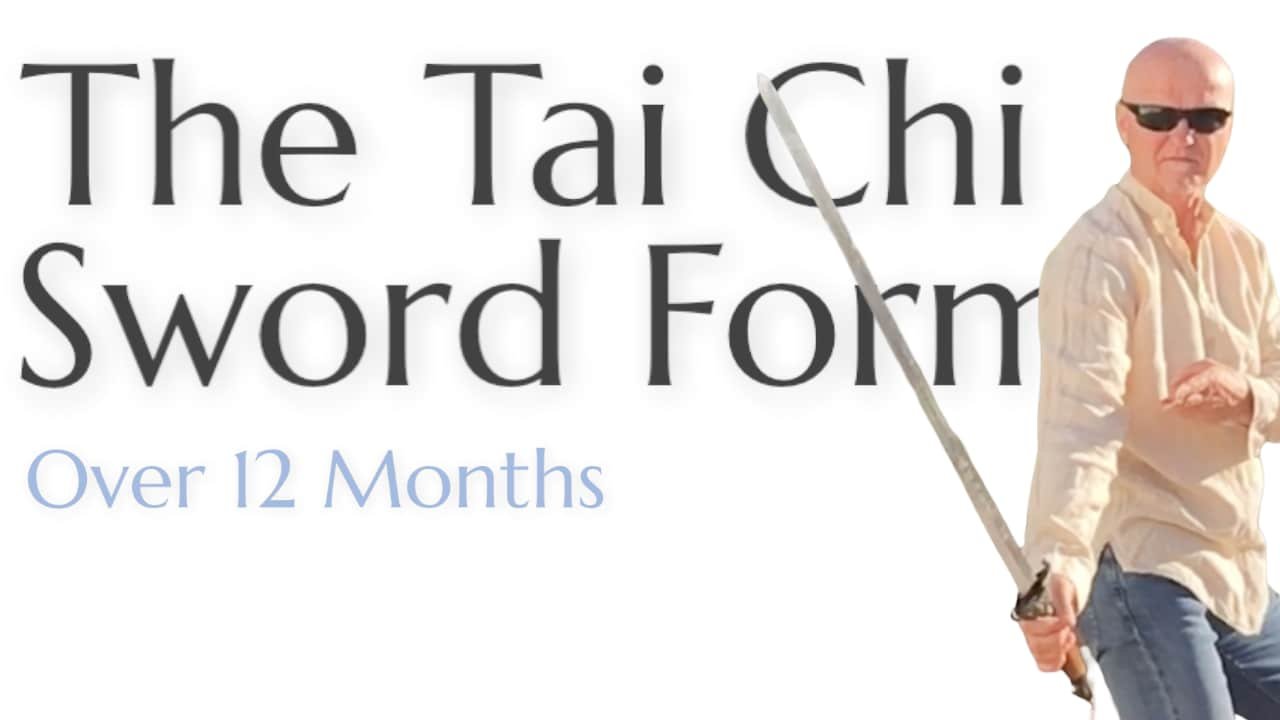A History of Sword Play with the teapOtmonk
The mOnk (who is not a mOnk) talks about Tai Chi, Sword Play and Early Sword Training with international journalist Gerald Greene (co-author of One Last Thing).
Early Weapons Training
Greene: People may know you from your online courses, your podcasts and irreverent videos, but you are less well known amongst the Pointy Sword Establishment. Could you tell us something of your background in traditional weapon training?
mOnksy: It all started when I was about 5. My younger brother and I would habitually dress in plastic medieval armour and clash swords over the most minor of reasons: Who got to eat the last Custard Cream biscuit or who got to be goalkeeper when we played footie in the street outside.
Greene: Did you ever go beyond plastic weaponry?
Early Sword Training (with protective gear)
mOnksy: No. I don't think so due to an incident that occurred a few years later. Whilst defending myself with a stick from a deadly pillow attack from above, I almost lost sight in one eye. I learnt that weapons could do as much damage to the wielder as the opponent, a lesson reinforced when I began learning the nunchaku in my teen years.
Going Beyond Plastic
Greene: I have a question here from a Inner Chamber Pointy Member who accuses you of not receiving any training beyond pillow defence work.
Kitchen training
mOnksy: Well, you can tell him that a few years later I began to learn Karate. There I was introduced to the Yawarra sticks, Nunchaku and a Shuriken (when someone brought in a fossilised starfish one evening.) But these only left me with a thirst for sharper and more pointy weapons. When I finally made it to college, I got to enrol in a fencing class.
Greene: So it started there?
mOnksy: It may have started there but it never developed, for I only attended one class. I was 18 and prone to get distracted by other things. I also joined the Parachute Society and the Alligator Appreciation League but never made it to a single meeting. A few years passed before I developed a sense of persistency and returned to the martial arts, this time learning a little of Gung fu and Aikido. Although neither of these were very pointy activities, I did manage to keep my interest in weapons alive at home, with the cheese board and the bread knife.
The 1980's
Greene: So how did that all that bring you around to Tai Chi sword?
Unforgettable: 1980s
mOnksy: As I was becoming aware of the limits of kitchen training, I started exploring the intriguing depths of the internal arts. You have to remember the context of the mid-1980’s. Globally, it appeared that Reagan and Thatcher were intent on bringing down what little was left of our collective dreams for a better world, replacing concepts such as the social good with individual wealth and personal greed. To deal with this new world order, some sought refuge in step-aerobic classes and leg-warmers, others escaped by adopting the Internal Arts. I did a bit of both. I trained as a fitness coach and at the same time learnt different Tai Chi styles, including the 32 step combined Sword Form from Wen Lin Jun.
Sword for Beginners
Greene: It is said that the Sword is the Mother of all Arms and that it takes:
100 days to dominate the Sabre
1000 days to dominate the Lance
10.000 days to dominate the Sword
Yet you offer tuition to the uninitiated, when others say it should only be learnt after the empty hand Forms.
mOnksy: It’s true that some instructors do like to repeat these time scales. But once again, I and others believe that the sword has too much to offer to be left to advanced students only, and, I believe this advice on time scales and training order derives from history in which learning sword was a matter of life and death. Additionally, swords back then were sharp, not like the ones we train with now. Today, sword teaches other skills, in a way that the empty hand cannot. In my experience, students quickly gain confidence and are more motivated to finish. They feel less naked in the classroom and more equal with others of different skill levels. The sword is a great leveller. It matters less if your balance is not so great or your swirls are not so big. But it isn’t just me that thinks it is a good idea to teach all everyone irrespective of level…
Greene: Who else?
mOnksy: Well, Wen Lin Jun. He didn’t insist on me having done years of Tai Chi training before taking up sword, nor did he enrol me on a course of 10.000 days. Then there are people like Petra Kobayashi author of Classical Tai Chi Sword who said:
“It is not only the advanced Tai Chi student who can learn sword. Tai Chi sword is known in China as an independent path of exercise that doesn't necessarily require knowledge of the other forms of Tai Chi.”
And the encyclopaedic Michael P. Garofalo. We discussed by email a decade back about teaching sword. He was another that offered training to anyone interested. And there is a historical precedent in this. Check out Cheng Man-ch'ing or Bruce Lee. They taught anyone who wanted to learn.
Posing for photo with Spanish Sword Class after giving Exhibition
Greene: But you can see why some other instructors may be worried that you offer to teach the uninitiated?
mOnksy: Not really. As I said before, we don't train with sharp blades. These are practice swords. They are blunt and harmless. A kitchen knife is far more lethal and easier to conceal. Anyway, I’m not offering a weekend teacher training certificate, nor Sifu-Status workshops. I’m offering a basis in sword handling that has little to do with stabbing or duelling, but more to do with tackling the strains and obstacles that arise in our daily life. It matters little if what you wield is a mop or a samurai sword, it's what lies beneath the lessons that are important: principles such as yielding and sticking, rooting and softness, that are understood and tested with greater clarity when using the Sword.
Why Sword is a Welcome Addition in the class
Greene: You said you were teaching Tai Chi before introducing Sword. How did you finally introduce the Sword into your classes?
Displaying Wooden tai Chi Swords in park in Spain
mOnksy: I did it progressively. I had been teaching empty hand Tai Chi Forms in the UK and Spain for many years, when one week I brought into class 20 bamboo poles I had cut down from the rivers-edge that morning. This was a cheap way to introduce the use of weapon training and a bamboo staff is, at the beginning, more user-friendly than a sword.
Greene: How did they react?
mOnksy: Initially they looked bemused, but curious. Then, within a few weeks, they grew to love it. Over time, we exchanged the bamboo poles for wooden tai chi practice swords.
Greene: Young people do like to play with weapons
mOnksy: These were not youngsters. The average age in my Sword class was 55- 75 plus.
Greene: Well, I suppose that men do get excited about such things. It is the same age group that buy fast motorbikes as a way of handling their middle aged crisis.
mOnksy: Possibly. I couldn’t say. My class was 99% women.
Greene: Oh.
Uhtred son of Uhtred
Whatever it is, the way you tell your story online can make all the difference.
mOnksy: Anyway, to my surprise they all embraced the Sword. Even those students who had just begun their Tai Chi training. Attendance and class satisfaction remained higher in the sword classes than in the empty hand classes. The exercises and the partner work seemed to encourage greater participation, energy levels and enthusiasm to attend. Either that or people just liked walking down the street with a sword on their backs, like Uhtred Ragnarsson.
Greene: Are you saying the Sword Form doesn’t take 10.000 days to learn?
mOnksy: For beginners, the sword form has more exaggerated and less subtle postures, so in a way the moves are easier to identify and remember. It is a shorter form too, and if you relax, the momentum and swing of the moves can show you what to do. It’s as if the sword is directing you and not the other way round. Additionally, I have to say, that sword is just more fun. It’s promise (if not its practice) of danger makes it thrilling too, and people love to talk about it in the class, joke, laugh and in doing so relax more. Personally, I believe this is the secret to effectively learning - encourage a greater sense of play in the class.
Online Sword Work
Greene: Other than a local class, you are now teaching sword as an online course. What convinced you that the sword, with its complexities and classroom challenges, could be taught in this way?
mOnksy: After having offered a number of other courses online these last few years, I was asked by a number of students to consider offering sword. So that’s what I have done. Yes, of course there are some limitations to online learning, but there are also huge advantages too.
Greene: What advantages are there to learning sword online?
mOnksy: The same pros and cons that exist for all online courses. Although you don’t get to train with a partner or a group (you can of course do the course with one or more friends) the classes are much cheaper and more convenient. You can study when, where and how often you like. You get to see the form and techniques from all angles without people standing in front of you and blocking your view, and you get to repeat classes or specific move as often as you like. You get back-up materials, step-by-step photographic, audio, visual and written instructions. From the feedback so far, this course has turned out to the most popular to date.
What can Sword Teach us?
Greene: You often write about the anachronism of the martial arts, with their need to update their aims and practices. How does sword fighting fit into this overview?
mOnksy: I’ve argued that there needs to be another emphasis from the martial arts community for lots of different reasons, and not solely to do with how effective or not the art is for the street.
Today, more instructors attempt to balance broader aims in their classes, but we still live in a world that has no equilibrium. Think about the martial skills for a moment. Most of us will never need to defend family or country with our fists or swords. We have a police force and an army for these things. We do, however still live in a world in which 5% of the population have everything whilst the rest of us bicker over the scraps under the table. The Chinese Boxers of the past and the great sword fighters of history come to mind as models for understanding and creatively responding to this imbalance.
Greene: Such as?
mOnksy: Spartacus and Robin Hood spring to mind. Or there is Syrio Forel - the Bravoss Dancer. Even the Tao Te Ching is clear on this :
“The Tao of heaven is to take from this that have too much and give to those that do not have enough”
Greene: And Sword can help us do this?
mOnksy: Thats depends on how it is taught. A blade can teach us that what is sharp, can easily become blunt. It can help us in the coordination of mind and body, finding a balance of weight and purpose, and a focus on breath and harmony that many of the empty hand Tai Chi forms lack. Metaphorically, it helps cut away the veil of illusion that social media inserts on your time-line and enables us to focus on other things than the size of our weapons. But, as I say, it depends on how it is taught.
Greene: Thanks for your time and unique perspective Mr. mOnk.
mOnksy: My pleasure Gerald.
Download Free Tai Chi Sword PDF and discover how to learn this beautiful art
23 pages of articles and information on the Tai Chi sword
The Essential Sword FAQ
Sword for Tai Chi Practitioners
Sword for Complete Beginners
Sword Course Details
Sample Sword Exercises
The 32 Posture Sword Images











